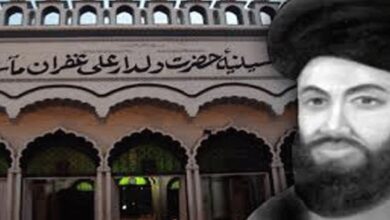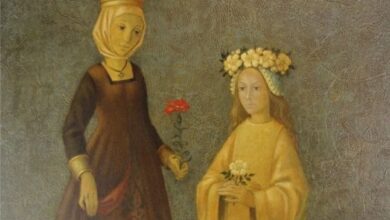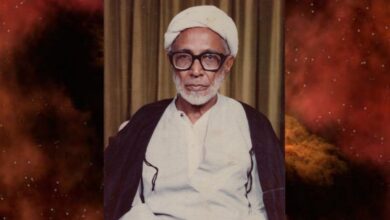Shiaphobia among the Sialvi sufis of Punjab – Prof. Tahir Kamran and Dr. Amir Khan Shahid
The Chishtiya silsilah was initiated in India by Mu‘in-ud-din Chishti in the twelfth century CE, but its resonance reached the Punjab courtesy Farid-ud-din Ganj Shakar, who established his dargah at Ajodhan (present-day Pakpattan in Pakistan). The bulk of its doctrine was developed in the subcontinent where it absorbed the cultural ethos, and it was recognised as arguably the most inclusive of all the local Sufi orders. Chishti Sufis adopted practices such as zikr (recollection of God) and sama’ (devotional music) as the spiritual signature of their silsilah, which also helped it in terms of assimilating with indigenous culture.
With Farid’s demise in 1265, the Chishtiya silsilah re-centred itself on Delhi with Nizam-ud-din Auliya as its principal protagonist. The ascendancy of Auliya as the central Chishti figure was synchronised with the split of the silsilah into Nizami and Sabri branches. Shaikh-ud-din ‘Ali Sabri (d.1291) of Kalyer (a small town near Roorkee) was the founder of the Sabri branch. However, Chishti-Sabri influence was confined only to Awadh and its surrounding areas. Thus its relevance with respect to Punjab remained just marginal. Now while reverting to the Chishti influence in the Punjab after Farid, Sanyal maintains, Chishtiya influence suffered an apparent decline until the eighteenth century. Throughout these centuries, the Punjab witnessed the waxing influence of the Qadiriya and Suharwardiya orders.
Neo-Sufism in the eighteenth and nineteenth centuries
The diminishing flame of Chishtiya mysticism was rekindled by a number of so-called neo-Sufis denoting new tendencies within the Sufi traditions, among them Fakhir-ud-din Dehlavi (1717–1785) and Shah Kalim Ullah (1650-1729). The impulse for Chishtiya resurgence, as Gilmartin contends, originated in Delhi where the decline of the Mughals was felt most intensely and it had explicit reflection on the works and thought of these two Chishti Sufis.
Its revival came about in the Punjab through Noor Muhammad Muharvi (1730–91), who established a khanaqah at the small town of Muhar near Bahawalpur in the mid-eighteenth century. The Chishtiya revitalisation subsequently reached its culmination in Taunsa, Golra and Sial Sharif. As a result of Muharvi’s influence, Sangharh, Ahmadpur, Chachran, Makhad, Jalalpur, Bahawalpur, Multan, Pakpatten, Dera Ghazi Khan, Hajipur, Rajanpur, Narwala, Muhammadpur, Ferozepur, Kot Mithan and Sultanpur (towns and cities located in South Punjab and Sindh) emerged as the prominent Chishti centres.
Muharvi faced a daunting task in terms of bringing about the Chishtiya renaissance primarily because, in the wake of dwindling Mughal power, Sikhs, Afghans and Marathas subjected the Punjab to their predatory raids. Punjab’s social fabric was virtually ripped apart, and moral decadence and social disorientation among Muslims presented a grisly picture. Siddiqi highlights the “dominant traits” of social and moral teachings from the malfuzat literature, Khulasa’t-ul Fawa’id and Khair-ul Afkar, on the life and achievements of Muharvi. In these teachings, primacy was accorded to “the ethical ideals and standard of Islam” in the code of conduct and the rules of behaviour. In a way, Muharvi’s teachings reconciled Sufis with the ‘ulama. In their synthesis of different, if not absolutely antithetical, strands of devotional and literal Islam, the latter had preponderance over the former. Muharvi too professed strict adherence to the shari‘a as a prerequisite for entering the fold of the tariqah, relegation of wahdat al-wujud as a discourse specific only to a chosen few and not meant for an open debate – it should be confined to only Akhas al-Khawas.
Muharvi also espoused dispensing with the ideological overtones of the controversy between ‘ilm and irfan. In such an ambience where new convergences were forged for the sake of reforming Muslims, the syntheses of wahdat al-wujud and wahdat al-shahud ideologies were thought to be imperative. This synthesis served as a bridge between “the orthodox and reformist Islam of the urban areas and the syncretic and meditational forms of rural areas”.
Taunsa and Sial Sharif
Shams-ud-din Sialvi (1799–1883), Muharvi’s ‘illustrious successor’ and the spiritual preceptor of Shah Sulaman Taunsvi (1770–1850) from Tuansa Sharif, district Dera Ghazi Khan, established his khanaqah in Sial Sharif, and directed Muslims “to cling tenaciously to the path of the Shariat, reform their manners and morals”. In the 1800s, Sulaman Tuansvi established the Dar-ul‘Ulum, a seminary at Taunsa, in which theological as well as mystical instruction was dispensed. More importantly the study of fiqh (Islamic jurisprudence) was ‘particularly stressed’ at the Dar-ul‘Ulum. That, indeed, was a departure from the established Chishtiya practice, since it privileged ‘ulum-i zahiri (exoteric knowledge) over ‘ulum-i batiniya (esoteric knowledge). Hence, the gradual practice of scriptural and puritanical exegesis of Islam by urban-based ‘ulama started to permeate the Chishtiya order, influencing folk Islam which was more tolerant and flexible and had been professed by Chishti Sufis since the medieval period.
Shi‘i proselytisation
In addition, what alarmed Sunni ‘ulama as well as Sufis in Punjab was Shi‘i proselytisation. In Gujrat (Punjab, Pakistan) Rizvi describes how some of the descendants of Makhdum Jahaniyan Shaikh Jalal-ud-din Bukhari, (1308–1387) embraced Shi‘ism. Similarly the guardians of the Uch khanaqah accepted Shi’ism. Several sayyid and tafdiliya families from Punjab began to renounce their Sunni faith. Ironically, however, Rizvi does not mention the time or the year for this denominational conversion. Rough estimates gleaned from his monumental account of the Isna ‘Ashari Shi‘as in India point fleetingly to the mid-nineteenth century as the time when it took place in some parts of the Punjab. Shah Jiwana and Rojoa Sa‘adat, prominent sayyid families from Jhang District, may well have embraced Shi‘ism by then. Similarly in the late-nineteenth century, graduates of the defunct Asaf-ud-daulah seminary of Lucknow travelled throughout North India to spread Usuli teachings. One such Usuli ‘alim, Abul Qasim Rizvi (1833–1906), vigorously promoted Usuli Shi‘ism in Lahore and its surroundings, founding congregational prayer mosques in the city and also an Imami seminary (in 1879) with the financial backing of Nawab ‘Ali Raza Khan Qizilbash. Highly influential families, like the Qizilbash, Faqir and Gardizi in Multan, contributed immensely in spreading the Shi‘i faith in the Punjab in the latter part of the nineteenth century.
In these circumstances, when Shi‘i ranks were swelling, it could be argued that Sialvi pirs would have regarded Shi‘i influence to be increasingly and uncomfortably encroaching upon their area of spiritual influence. Sayyid Muhammad Ghaus, Sayyid Chiragh Shah, Sardar Husain Shah and Sayyid Ghulam ‘Abbas were among the Shi‘a Rajoa Sayyids in Chiniot tehsil of Jhang District who held positions of pre-eminence under British rule. The colonial Gazetteer of Jhang District of 1883–84 contained information about the presence of Shi‘as, which would have been alarming to the pirs of Sial Sharif:
“Shi‘as are unusually numerous in Jhang, a fact due to the influence of the Shi‘a Kuraishis of Shorkot and Hassu Balel, and the Sayads of Uch who are connected with the famous Sayad family of Belot in Dera Ismael Khan District and Shah Jiwana and Rajoa in the Jhang District. They are the most bigoted type. They observe the Muharram most strictly, abstaining from all luxuries for the first ten days of the month, and on the 10th they accompany the Taziahs bareheaded and bare-footed. They throw dust on their heads and beat their breasts with extreme violence, and allow neither Hindu nor Muhammadan to approach the Taziah without baring his head and removing his shoes.”
In 1929, the District Gazetteer likewise explained the increasing hold of Shi‘as in the district: “Shi‘ism is on the increase in the district. The influx of wealth on account of canal irrigation has invested some Sayyid families with added importance, and has proved helpful in spreading Shi‘ism”.
‘Rawafiz’ and Mazhab-i Shi‘a
It is against the above background that the chapter, entitled ‘Rawafiz’, in Shams-ud-din Sialvi’s Malfuzat Miraat-ul ‘Ashiqeen translated from Persian by Ghulam Nizam-ud-din Maurolvi and put together by his disciple Muhammad Sa‘id, can be discussed. The exact date of the conversation on which the narrative is based is not known, though tentatively speaking, the late nineteenth century seems plausible. That book could not be published before 1970, almost 90 years after Sialvi’s death..
The other text under review is Qamar-ud-din’s book Mazhab-i Shi‘a (1957). In addition to Shi‘a influence, it is important to differentiate between the late colonial period and the early post-independence period of Pakistan which is reflected in these writings, one sample of which will be scrutinised below. The colonial period was, as we have seen, a period of competing revivalisms, marked by the emergence of a politics of religious identity that pitted Sunnis against, first, Ahmadis and, later, Shi‘a, against a backdrop of intense conflict about the role of religion in public life.
Hagiographical accounts of Shams-ud-din, such as Fauz-ul Miqal fi Khulafa-i Pir Sial, make no reference to his disapproval of Shi‘as. However his malfuzat Mira’t-ul-‘Ashiqeen contains a chapter on Rawafiz (denoting Shi‘as), with Shams-ud-din responding to the questions asked him by his disciples. His emphatic advice to them is that the faith is not complete (iman-i kamil) until one accepts all the Companions, righteous and truthful. Qamar-ud-din Sialvi’s 125-page book Mazhab-i Shi‘a, published in 1957, is significant for its rarity as, unlike other malfuzat literature, it was authored by the Sialvi pir himself.
From the eighteenth century onwards, therefore, Shi‘a-Sunni (read Chishti here) antagonism appears to be predicated on their respective perceptions of the first three Caliphs. Chishti pirs, assuming an antithetical position vis-a-vis Shi‘as, marked a departure from their fundamental postulates which, in their very essence, should have transcended any sectarian persuasion. With the onset of Chishtiya revivalism, the proponents of that silsilah shunned to a substantial extent its all-inclusive character and redefined what they believed in the light of foundational texts.
Sialvi pirs represented this trend whereby the shari‘a came to hold centrality in the re-defined Chishtiya belief system. The proselytization of Usuli Shi‘ism in the Punjab exacerbated sectarian differences. These developments were construed in
myriad ways, one of which had been Qamar-ud-din Sialvi’s anti-Shi‘a zeal, articulated in the Mazhab-i Shi‘a.
Download “Tanzih ul-Imamia”, rejoinder to “Mazhab-i Shia” by Allama Muhammad Hussain Najafi
Source: Tahir Kamran and Amir Khan Shahid, “Shari’a, Shi’as and Chishtiya Revivalism: Contextualising the Growth of Sectarianism in the Tradition of the Sialvi Saints of the Punjab”, Journal of the Royal Asiatic Society, Vol. 24 (3), Special Issue: Isna ‘Ashari and Isma’ili Shi’ism: from South Asia to the Indian Ocean (July 2014), pp. 477-492.



